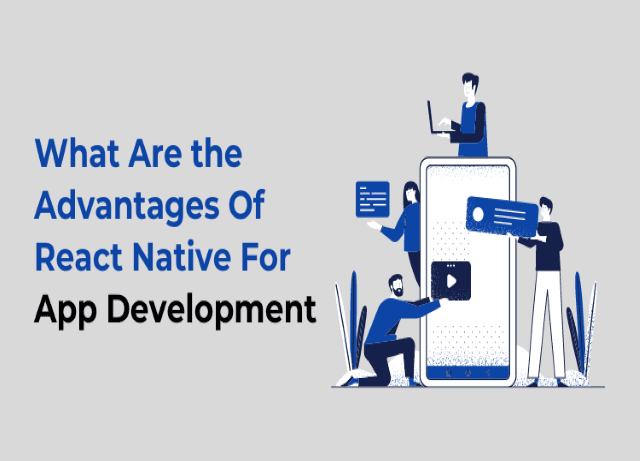With React Native, you can build native apps for both iOS and Android using a single framework. Facebook introduced it in 2015, and since then, numerous businesses have started using it.
As a result, a growing number of businesses are building their mobile apps with React Native taking help from a Mobile App Development Company in less time. This is due to the fact that, compared to competing frameworks, it offers many benefits, including:
In comparison to other frameworks, React Native’s wide range of components is tailored for mobile devices rather than desktop browsers, which results in a superior user experience. Android devices have a navigation bar built for touch gestures, whereas iOS devices hide the keyboard while editing text.
React Native’s minimal learning curve in comparison to other cross-platform frameworks is another plus. Due to its accessibility and compatibility with commonly used tools, this bodes well for the spread of React Native.
We’ll discuss when it makes sense to use React Native and when it doesn’t, as well as its benefits, popularity, and prospects.
Features that make React Native worth your time and effort:
In order to create mobile apps, you can use the cross-platform React Native framework.
One such framework is React Native, which facilitates the creation of native mobile applications. It’s built on the same ideas as React, so it’s simple to pick up and use. It also facilitates the development of natively created applications with the aid of Best JavaScript Framework and other well-known programming languages.
Unlike hybrid apps, which must deal with the difficulties of rendering views on multiple platforms, React Native is focused on speed.
If your target users are predominantly on iOS and Android, React Native is a great choice for developing your cross-platform software. More than that, it will facilitate the development of programs that are cross-platform and compatible with both platforms without further effort on your part.
Therefore, you may create an app through a reliable mobile app development company that is compatible with both platforms and can be deployed on Windows, macOS, and Linux. Additionally, you can use the React Native developmenttools right in your web browser, and then export your apps as native Android and iOS apps.
Here are just a few of the many compelling arguments for including React in your next cross-platform mobile app development project:
Effective in terms of both money and effort spent:
Writing mobile apps with React Native is easy because it’s a framework that works across several platforms. It’s written in JavaScript, one of the most widely used programming languages. With the help of React Native, programmers can now make apps that feel more at home on a user’s device. As a result, they’ve been able to save money and time on the creation of mobile apps. With React Native, programmers can write code in unmodified JavaScript without having to worry about compilation.
In terms of developing mobile apps, this is one of the quickest methods.
How difficult is it to get started using React Native?
The only two are actual practice with the language and familiarity with the available tools. However, thanks to React Native’s ease of use, most mobile application development services providers should be able to be up and running in about an hour.
Create reliable, high-performing software:
To build user interfaces for mobile apps, developers can use the JavaScript framework React Native. If you wanna create apps for both iOS and Android, you may do it using this platform because it’s a cross-platform solution. React Native offers dynamic UI updates, giving it the sense of a phone app. React Native offers dynamic UI changes, giving it the feel of a phone app.
Accepts Plugins from Outside Sources:
React Native has become the go-to technology for designing cross-platform mobile apps. It’s a package that allows programmers to use the same JavaScript and web APIs to create native mobile apps. Third-party plugins bring many valuable functionalities to React Native apps. It’s a mobile-optimized language that compiles native code, making it easy to design powerful apps. Using the Ionic platform, you can create stunning Cordova-based mobile apps.
The word “components” is what the library’s APIs are built around.
Just what are Ionic’s perks, exactly? You can construct everything you can imagine. You can use the native components and the extensive library of plugins and components to make spectacular user experiences.
Users will have a more responsive experience with apps built with Ionic because of the reduced memory requirements, reduced permissions, and increased performance.
Allows for Code Reuse:
To create mobile apps that run on several platforms, developers can use the React Native framework. Based on the JavaScript package ReactJS allows for the creation of dynamic user interfaces. This allows you to spend less time creating code and more time building your app, as the code can be utilized with no changes for both Android and iOS. When making an app for several platforms by yourself or through a mobile app development company, this is crucial.
When you use the Android Support Library, your program will work with Android 2.2 and up, as well as prior versions of Android. This library contains a group of auxiliary classes for a design that isn’t normally included in a “bare bones” implementation of the API level you’re shooting for. For instance, the Vector, and Drawable classes needed to work with API 9 are included in the support library even if they aren’t used.
Make Available Thorough Resource Centres:
When creating apps for both Android and iOS, you may use React Native for a streamlined experience. Thanks to React Native’s compatibility with the respective native APIs of both platforms, you may have the best of both worlds. You may use its extensive collection of open-source libraries to build any kind of mobile app you can imagine, from data management to animations.
Since React Native is built on JavaScript, developers have several options when designing apps. Because the tools are similar to those in other languages, there’s a little learning curve.
Should you use React Native if you’re building a mobile app?
You can build apps for Android, iOS, and Windows with the help of React Native. For rendering views, React Native makes use of both JavaScript and native components.
- React Native is a Facebook-created open-source JavaScript library for mobile app UIs.
- Airbnb, Atlassian, Facebook, Instagram, Skype, and start-ups like Happyfresh and Lyft use React Native.
- A React Native app of the same quality and functionality costs less to produce.
Conclusion:
Finally, React Native offers multiple benefits to creating an App. You may have a Native app’s appearance and feel without developing one and in less time. But before you commit to a specific technology stack, it’s crucial to think about your company’s requirements. If you need assistance finding and hiring react native developers for your project, a reputable mobile app development company will help. Superior quality cross-platform mobile apps for your company are available from this company.

As the editor of the blog, She curate insightful content that sparks curiosity and fosters learning. With a passion for storytelling and a keen eye for detail, she strive to bring diverse perspectives and engaging narratives to readers, ensuring every piece informs, inspires, and enriches.

![Best Business Ideas in Rural Areas in India [Rural Business Ideas] business ideas](https://www.justgetblogging.com/wp-content/uploads/2025/03/business-ideas-150x150.jpg)








